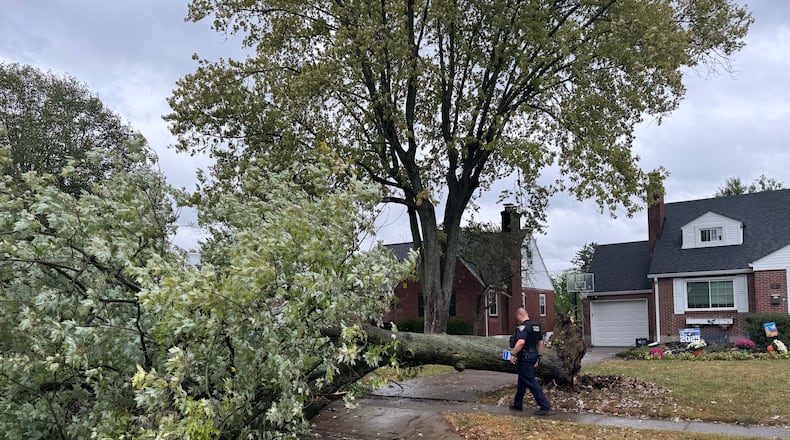Representatives of the Office of the Ohio Consumers’ Counsel objected this summer as AES Ohio crafted settlements with interested parties over failure to meet reliability standards in recent years — settlements that would penalize the utility $30,000 for falling short.
That penalty is insufficient, argues Maureen Willis, the state’s consumers’ counsel.
“$30,000 is not really very much money at all for a corporation that’s the size of AES,” she said.
Parent company AES Corp. — the Arlington, Va. company that bought the former Dayton Power & Light, now AES Ohio, in 2011 — saw total revenue of more than $6 billion in the six months that ended June 30, 2024.
“Just giving them a $30,000 fine, I think that doesn’t do it,” Willis said.
AES officials say they are taking steps to improve their system’s reliability — evident in the utility improving and meeting the industry standard in 2023 — though recent storms have shown just how fragile the region’s power infrastructure is.
Credit: Jim Noelker
Credit: Jim Noelker
‘Historic weather event’
The remnants of Hurricane Helene affected more than 130,000 Dayton-area residents, starting on the afternoon of Friday, Sept. 27.
Two days later, AES Ohio said its crews continued to work around the clock. At that point, 635 employees or contractors had restored power to 93% of affected Dayton-area customers, and the goal was to reach 95% of customers by Tuesday, AES said.
Crews are working around the clock. Less than 20,000 customers are without service. 635 team members have restored power to 93% of affected customers & aim for 95% by Tuesday evening. Stay cautious as rain-soaked trees may cause additional outages. Thank you for your patience! pic.twitter.com/uJL9E0uuaY
— AES Ohio (@AESOhio) September 29, 2024
“Coming up on day 3 @AESOhio … in a semi big city… with your rates.. terrible. Just awful. Time for @PUCOhio to come down hard,” wrote one user on X, the former Twitter social media platform. (The PUCO is the Public Utilities Commission of Ohio, a body of state regulators overseeing Ohio utilities.)
“Thank you @AESOhio crews,” wrote another X user, Brian Cooper, on Saturday. “Our power is back on. We were without for about 24 hours, but it could have been much worse.”
Clyde Spencer, of Fairborn, said the longest power outage he has previously endured was about six hours.
This one lasted 51 hours.
“My subdivision has all underground utilities, so direct local damage should have been minimal,” Spencer told the Dayton Daily News. “It was only by the good graces of my next-door neighbor, who had power and supplied an extension cable, that I was able to save my perishables.”
He added: “I’m wondering what the AES Ohio ‘stability charges’ have been used for,” a reference to a stability charge or rider AES Ohio charges that has been contested by the Office of the Ohio Consumers Counsel.
Mary Ann Kabel, a spokeswoman for AES Ohio, thanked customers for their patience and said the company does pay attention to phone calls and messages on social media.
“We do hear you, we do listen, we do watch,” she said.
Early in August, a different storm waylaid the Cleveland area. Nearly 500,000 Northeast Ohio homes and business were left in the dark for days.
Torrence Hinton, president of Akron’s FirstEnergy Ohio Utilities, called it a “historic weather event.”
At its peak, some 470,000 homes were affected. Rainfall exceeded two inches in the region, with five confirmed tornadoes tearing through the Cleveland area, the worst storm to affect the utility’s coverage area since 1993.
The tornadoes tore through the area on a Tuesday, Aug. 6. While power was restored to 85% of customers within 100 hours, nearly a week later, on the following Monday, nearly 7,000 customers were still without power.
“Customers understandably want to know when their power will be restored,” Hinton told the PUCO.
Ohio was among the top five U.S. states that experience the most weather-related power outages, according to a recent study.
Climate Central collected utility companies’ power outage data from 2000 to 2023, defining major outages as events that affect at least 50,000 customers.
From the report: The states with the most reported weather-related power outages in that time span were: Texas (with 210 outages); Michigan (157); California (145); North Carolina (111); and Ohio (88).
More broadly, though, U.S. power is considered reliable. According to the National Renewable Energy Laboratory, the average U.S. customer loses power less than twice a year for a total of less than five hours, which represents 99.95% reliability, the lab said in January.
In an interview from Atlanta (where he was temporarily without power as Helene tore inland on its northbound trek), John Moura, director of reliability assessment and performance analysis at the North American Electric Reliability Corp., said the U.S. power industry is changing.
Traditional fuel sources such as coal are being taken offline in exchange for more wind, solar and storage sources.
The good news: According to the Environmental Protection Agency, since 1995, sulfur dioxide emissions from power plants have fallen 95%, nitrogen oxides emissions have fallen 89%, and carbon dioxide emissions have dropped 25%.
But there has been a price.
“We’ve never really had a resource mix this different where we didn’t really understand, didn’t really have a lot of certainty around the fuel availability,” said Moura.
“That’s a challenge,” he added. We’re increasing demand at an “incredible rate” — electric vehicle charging, AI computing, data centers, more utilization of heat pumps (and more) imposes ever-growing power demands, he said.
“The amount of energy we have in our system is degrading, but also, it’s coming in different, uncertain patterns,” Moura said.
AES Ohio ‘taking proactive action’
Rob Fadley, director of service monitoring and enforcement for the PUCO, said staying on top of reliability is one of the commission’s most important jobs.
When electric utilities fail to keep the lights on, they pay a price, said Fadley and a spokeswoman for the PUCO, Brittany Waugaman.
That price isn’t high enough, some observers counter.
The industry standard for time without power for AES Ohio (the former Dayton Power and Light, or DP&L) in 2019 and 2020 was an average of just over 125 minutes. But it took the utility an average of more than 133 minutes in 2019 and more than 132 minutes in 2020 to restore service, according to testimony before state regulators.
CAIDI — “Customer Average Interruption Duration Index” — is the standard that governs how long it takes for a utility restore power. AES Ohio didn’t meet that standard for four years — 2019, 2020, 2021 and 2022.
The utility’s performance since then has improved.
In 2022, AES Ohio took about 125.5 minutes to restore power once it was interrupted, just shy of the standard, PUCO data shows. In 2023, it took 123 minutes on average, beating the standard of 131.87 minutes that year.
If AES fell short of reliability standards in 2021 and 2022, the utility was to pay $20,000, an amount held in abeyance. The utility in fact paid that amount, a PUCO spokeswoman told the Dayton Daily News in June.
Neither Fadley nor a PUCO spokeswoman would comment in detail on AES Ohio’s performance or the two proposed settlements because the settlements are pending.
AES Ohio’s Kabel pointed to the company’s improved performance in 2022 and ‘23.
“Our weather is changing,” Kabel said in an interview before the remnants of Helene hit the area. “We’ve seen it, from the tornadoes that we’ve had.”
AES Ohio’s work includes controlling the growth of vegetation around power lines, trimming trees, installing stronger utility poles, installing underground primary cables and more.
In a March 2023 report to the PUCO, AES Ohio said:
- Beginning in the late summer of 2021, the utility spent $183,000 on vegetation management. In 2022, it spent $497,601.35.
- The business installed more reclosers, devices the company says allow it to sectionalize circuits automatically, reducing the number of customers who experience a sustained outage.
- The company brought on a team in 2022, “whose sole purpose is to identify and drive improvements to operational performance and customer reliability.”
“We’re taking proactive action,” Kabel said. “Conditions are different. Conditions are different in terms of the weather and the severity. We’re addressing those.”
‘Paying a lot of money for reliability’
The PUCO’s Fadley said utilities in Ohio have steadily become more reliable over the last decade.
In general, the PUCO expects power companies to produce plans to address aging infrastructure, replace or strengthen poles, install smart grids that help power companies more quickly spot outages or take other steps.
“When a utility doesn’t meet those standards, the PUCO has a responsibility to investigate, to direct them to improve, to have enforcement action. Again, it all comes down to that reliable electric service,” said Waugaman, a spokeswoman for the PUCO.
Said Fadley: “It’s in their best interest to keep the lights on, not just from a regulatory standpoint, but from a business standpoint.”
Waugaman said an administrative law judge will assess AES Ohio’s settlements cases. She expects the commission to consider the settlements at some point this year. (As of Sept. 30, votes on the settlements had not been scheduled.)
Willis said Dayton-area consumers already pay a distribution management “rider,” or charge, a vegetation management rider, a storm cost recovery rider and an infrastructure investment rider.
AES Ohio customers pay $45 a year just for those riders, not counting base distribution rates, she said.
“The 519,000 customers of AES are paying a lot of money for reliability,” Willis said. “And it doesn’t seem like they’re getting it.”
“It’s just a lot of money,” she added. “You say, ‘OK, you’re providing a lot of money. What are we getting for that money?’”
The ‘three legs of the stool.’
A better approach, in the view of the consumers’ office: Penalize a utility’s bottom line. Reduce a power company’s authorized return. Turn to the base distribution rates formula. Dock the utility’s profit level.
“Instead of earning 10%, maybe you’ll earn 9%,” Willis said.
She would also like to see greater bill payment assistance to consumers who are at risk of having their power turned off.
Moura, of the the North American Electric Reliability Corp, said electric generation systems are neutral or “agnostic” when it comes to the type of fuel being used to generate power.
“It really doesn’t matter what kind of resources you have, so long as you make sure the transmission is reliable, and you’re confident in the fuel sources,” he said.
He points to the “three legs of the stool” of power.
- Diversity: Build a diversity of resources, particularly resources not affected by the weather.
- Transmission: Access to “excess energy” from neighbors. “That’s something that’s just new for the industry,” he said. The challenge there is big transmission sources, such as stronger power lines, can take a decade or more to build.
- And the last leg of the stool: Attend to the demand side. Shift an area’s peak demand. Use power storage.
“Every area is going to grapple with their own energy deficits,” Moura said.
About the Author




